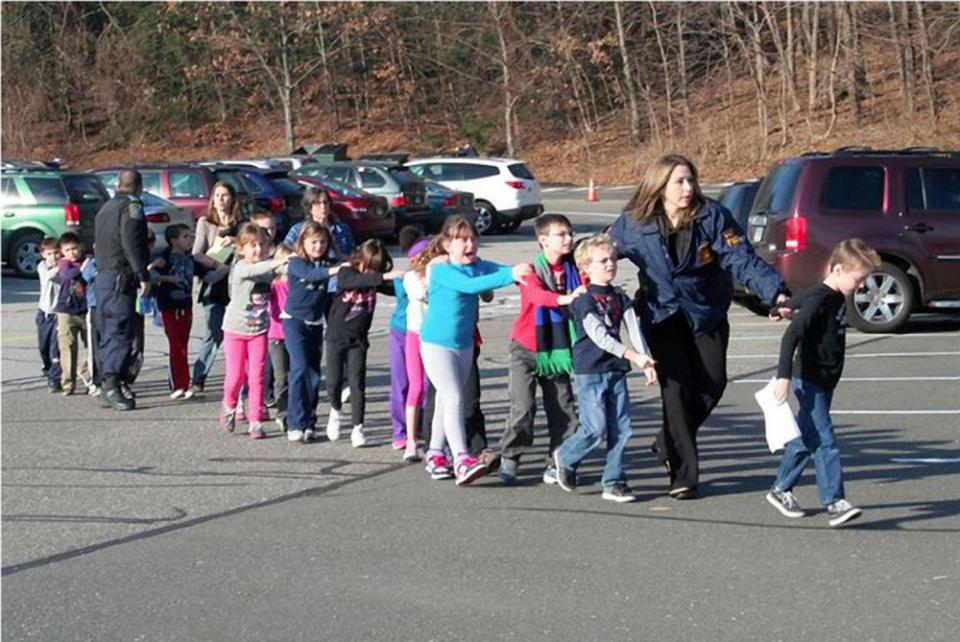PSA From Sandy Hook Parents Spotlights Warning Signs of Potential School Shooters

Six years have passed since Nicole Hockley lost her son in the school shooting at Sandy Hook Elementary School in Connecticut, but his untimely death still brings tears when she least expects it.
Her son, Dylan Hockley, 6, died on Dec. 14, 2012, when a gunman stormed the Newtown school and fatally shot 20 children and six staff members before turning the gun on himself.
“In December, as I get closer to the (anniversary) date, I go on a large emotional rollercoaster,” Hockley tells PEOPLE. “I was driving to the train station yesterday and burst into tears for no reason — well, I know for what reason.”
For Mark Barden, who lost his son, Daniel, 7, in the massacre, the days leading up to the anniversary “are still just another day in the constant struggle,” he tells PEOPLE.
What helps both parents persevere is their work with Sandy Hook Promise, the national nonprofit they helped found in 2013 focused on gun violence prevention.
• Want to keep up with the latest crime coverage? Click here to get breaking crime news, ongoing trial coverage and details of intriguing unsolved cases in the True Crime Newsletter.
Starting Monday, SHP is unveiling its newest public service announcement to teach people how to spot the crucial warning signs of potential school shooters and to speak out before another tragedy steals more lives.
“Gun violence is preventable,” says Hockley.
Set in a high school in the days leading up to a school election, the fictional video, Point of View, shows warning signs of a shooter planning an attack.

“The warning signs are there almost every time somebody hurts themselves or someone else and our whole mission is to train people how to recognize them and report at-risk behavior,” says Barden.
SHP’s Six Warning Signs of Potential Shooters:
School shooters typically exhibit a strong fascination or obsession with firearms.
School shooters often overreact or act out aggressively for seemingly minor reasons.
Perpetrators of self-harm or violence towards others may be victims of prolonged bullying and may also have real or perceived feelings of being picked on or persecuted by others.
They also usually study firearm techniques and training and are fascinated by mass shootings.
School shooters almost always have unsupervised, illegal or easy access to firearms, and often brag about such access.
They can exhibit gestures of violence or a sudden change in academic performance.
Proven Results
The information in the PSA — one of several SHP has rolled out since their first award-winning PSA, Evan, in 2016, which drew 155 million views on social media — and the framework SHP created to spot the warning signs are making a difference, says Barden.
“It works,” he says. “We have case histories and anecdotal evidence where mass shootings have been stopped and averted from the work we’re doing and from people following the model and uncovering something before it happens.”
Speaking up is easier, too, says Barden, “especially now that we have the Say Something Anonymous Reporting System, which has really taken off.”
The Say Something Anonymous Reporting System allows students and adults to submit secure and anonymous safety concerns to help identify and intervene upon at-risk individuals before they hurt themselves or others via email, an app or by calling the 1-844-5-SAYNOW Hotline.
This is critical, says Hockley, since the number of school shootings is greater than ever.
“There have been almost 100 school shootings this year alone so far and over 300 mass shootings so far,” says Hockley.
“What makes it more heartbreaking is not just that the violence is increasing but that these acts are so preventable,” she says. “People that they have actions that they can take and be part of the solution.”
Showing Compassion
SHP also teaches people to spot the signs of social isolation in someone who could be headed down a path of self-harm or harming others.
“These individuals are often loners, often bullied and often victims of isolation, so I hope that [the PSA] elicits feelings of compassion to report at-risk behavior and help get somebody connected to whatever services that they need,” says Barden.
“We can change this,” he says.
The Say Something Anonymous Reporting System can be contacted anonymously via email, an app or by calling the 1-844-5-SAYNOW Hotline.
